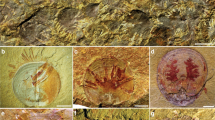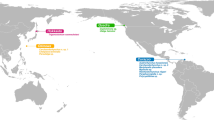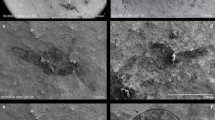Abstract
Symbiotic relationships are widespread in terrestrial and aquatic animals today, but evidence of symbiosis in the fossil record between soft-bodied bilaterians where the symbiont is intimately associated with the integument of the host is extremely rare. The radiation of metazoan life apparent in the Ediacaran (~635–541 million years ago) and Cambrian (~541–488 million years ago) periods is increasingly accepted to represent ecological diversification resulting from earlier key genetic developmental events and other innovations that occurred in the late Tonian and Cryogenian periods (~850–635 million years ago). The Cambrian has representative animals in each major ecospace category, the early Cambrian in particular having witnessed the earliest known complex animal communities and trophic structures, including symbiotic relationships. Here we report on newly discovered Cricocosmia and Mafangscolex worms that are hosts to aggregates of a new species of tiny worm in the lower Cambrian (Series 2, Stage 3) Chengjiang Lagerstätte of Yunnan Province, southwest China. The worm associations suggest the earliest known record of aggregate infestation of the integument of a soft-bodied bilaterian, host specificity and host shift.
This is a preview of subscription content, access via your institution
Access options
Access Nature and 54 other Nature Portfolio journals
Get Nature+, our best-value online-access subscription
$29.99 / 30 days
cancel any time
Subscribe to this journal
Receive 12 digital issues and online access to articles
$119.00 per year
only $9.92 per issue
Buy this article
- Purchase on Springer Link
- Instant access to full article PDF
Prices may be subject to local taxes which are calculated during checkout




Similar content being viewed by others
References
Hou, X. et al. The Cambrian Fossils of Chengjiang, China: The Flowering of Early Animal Life. 2nd edn (Wiley Blackwell, Oxford, 2017).
Müller, K. J. & Hinz-Schallreuter, I. Palaeoscolecid worms from the middle Cambrian of Australia. Palaeontology 36, 549–592 (1993).
Dong, X. et al. The anatomy, taphonomy, taxonomy and systematic affinity of Markuelia: early Cambrian to early Ordovician scalidophorans. Palaeontology 53, 1291–1314 (2010).
Paracer, S. & Ahmadjian, V. Symbiosis: An Introduction to Biological Associations (Oxford Univ. Press, Oxford, 2000).
Douglas, A. The Symbiotic Habit (Princeton Univ. Press, New Jersey, 2010).
Conway Morris, S. Parasites and the fossil record. Parasitology 82, 489–509 (1981).
Conway Morris, S. in Palaeobiology: A Synthesis (eds Briggs, D. E. G. & Crowther, P. R.) 376–381 (Blackwell, Oxford, 1990).
Baumiller, T. K. & Gain, F. J. Fossil record of parasitism on marine invertebrates with special emphasis on the platyceratid–crinoid interaction. Paleontol. Soc. Papers 8, 195–209 (2002).
De Baets, K. & Littlewood, D. T. J. (eds) in Advances in Parasitology 1–51 (Academic Press, London, 2015).
Leung, T. L. F. Fossils of parasites: what can the fossil record tell us about the evolution of parasitism? Biol. Rev. 92, 410–430 (2015).
Siveter, D. J., Briggs, D. E. G., Siveter, D. J. & Sutton, M. D. A 425-million-year-old Silurian pentastomid parasitic on ostracods. Curr. Biol. 23, 1–6 (2015).
Vinn, O. Early symbiotic interactions in the Cambrian. Palaios 32, 231–237 (2017).
Zhang, Z., Han, J., Wang, Y., Emig, C. C. & Shu, D. Epibionts on the lingulate brachiopod Diandongia from the early Cambrian Chengjiang Lagerstätte, South China. Proc. R. Soc. B 277, 175–181 (2010).
Wang, H. et al. Peduncular attached secondary tiering acrotretoid brachiopods from the Chengjiang fauna: implications for the ecological expansion of brachiopods during the Cambrian explosion. Palaeogeog. Palaeoclimatol. Palaeoecol. 323, 60–67 (2012).
Topper, T. P., Holmer, L. E. & Caron, J.-B. Brachiopods hitching a ride: an early case of commensalism in the middle Cambrian Burgess Shale. Sci. Rep. 4, 6704 (2014).
Martin, D. & Britayev, T. A. Symbiotic polychaetes: review of known species. Oceanogr. Mar. Biol. 36, 217–340 (1998).
Pawlik, J. P. Chemical ecology of the settlement of benthic marine invertebrates. Oceanogr. Mar. Biol. 30, 273–335 (1992).
Huang, D., Chen, J., Zhu, M. & Zhao, F. The burrow dwelling behavior and locomotion of palaeoscolecidian worms: new evidence from the Cambrian Chengjiang fauna. Palaeogeog. Palaeoclimatol. Palaeoecol. 398, 154–164 (2014).
Simon, J. C. et al. Host-based divergence in populations of the pea aphid: insights from nuclear markers and the prevalence of facultative symbionts. Proc. R. Soc. B 270, 1703–1712 (2003).
Munday, P. L., van Herwerden, L. & Dudgeon, C. L. Evidence for sympatric speciation by host shift in the sea. Curr. Biol. 14, 1498–1504 (2004).
Fordyce, J. A. Host shifts and evolutionary radiations of butterflies. Proc. R. Soc. B 277, 3735–3743 (2010).
Hu, S. Taphonomy and Palaeoecology of the Early Cambrian Chengjiang Biota from Eastern Yunnan, China (Selbsteverlag Fachrichtung Paläobiologie, Institute für Geologische Wissenschaften, Freie Universität Berlin, Berlin, 2005).
Zhang, X., Liu, W. & Zhao, Y. Cambrian Burgess Shale-type Lagerstätten in South China: distribution and significance. Gondwana Res. 14, 255–262 (2008).
Vannier, J., Calandra, I., Gaillard, C. & Żylińska, A. Priapulid worms: pioneer horizontal burrowers at the Precambrian–Cambrian boundary. Geology 38, 711–714 (2010).
Landing, E., Geyer, G., Brasier, M. D. & Bowring, S. A. Cambrian evolutionary radiation: context, correlations, and chronostratigraphy—overcoming deficiencies of the first appearance datum (FAD) concept. Earth Sci. Rev. 123, 133–177 (2013).
Jensen, S. The Proterozoic and earliest Cambrian trace fossil record; patterns, problems and perspectives. Integr. Comp. Biol. 43, 219–228 (2003).
Jensen, S., Droser, M. L. & Gehling, J. G. The fossil preservation and the early evolution of animals. Palaeogeog. Palaeoclimatol. Palaeoecol. 220, 19–29 (2005).
Erwin, D. H. et al. The Cambrian conundrum: early divergence and later ecological success in the early history of animals. Science 334, 1091–1097 (2011).
Erwin, D. H. & Valentine, J. W. The Cambrian Explosion: The Construction of Animal Biodiversity (Roberts and Company, Colorado, 2013).
Bambach, R. K., Bush, A. M. & Erwin, D. H. Autecology and the filling of ecospace: key metazoan radiations. Palaeontology 50, 1–22 (2007).
Acknowledgements
The reconstruction in Fig. 4 was produced by R. Nicholls (http://paleocreations.com). The research was funded by the National Natural Science Foundation of China (41572015 and U1302232), a Natural Environment Research Council Independent Research Fellowship (NE/L011751/1), Leverhulme Trust grants (RPG-2015-441 and EM 2014‐068), a Royal Society International Joint Project (IE131457) and a Yunnan Innovation Research Team grant (2015HC029).
Author information
Authors and Affiliations
Contributions
P.C. and X.M. conceived the project and led the team. P.C., X.M., X.H. and D.Z. collected and prepared the specimens. T.G., S.E.G., G.D.E. and P.C. conducted the scanning electron microscop and element mapping analyses. Derek J.S. and P.C. photographed the specimens and prepared the figures. M.W. and P.C. produced the camera lucida drawings. X.M. calculated the infestation rates. All authors interpreted the data. M.W. and David J.S. wrote the initial draft with scientific and editorial input from P.C., X.M., G.D.E., S.E.G. and Derek J.S.
Corresponding author
Ethics declarations
Competing interests
The authors declare no competing financial interests.
Additional information
Publisher’s note: Springer Nature remains neutral with regard to jurisdictional claims in published maps and institutional affiliations.
Electronic supplementary material
Supplementary Information
Supplementary Figures, Supplementary Tables and Supplementary References
Rights and permissions
About this article
Cite this article
Cong, P., Ma, X., Williams, M. et al. Host-specific infestation in early Cambrian worms. Nat Ecol Evol 1, 1465–1469 (2017). https://doi.org/10.1038/s41559-017-0278-4
Received:
Accepted:
Published:
Issue Date:
DOI: https://doi.org/10.1038/s41559-017-0278-4
This article is cited by
-
Rhabdopleurid epibionts from the Ordovician Fezouata Shale biota and the longevity of cross-phylum interactions
Communications Biology (2023)
-
An encrusting kleptoparasite-host interaction from the early Cambrian
Nature Communications (2020)
-
Symbiotic fouling of Vetulicola, an early Cambrian nektonic animal
Communications Biology (2020)



